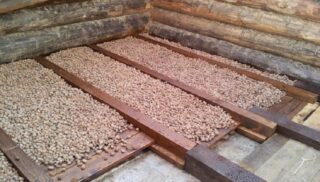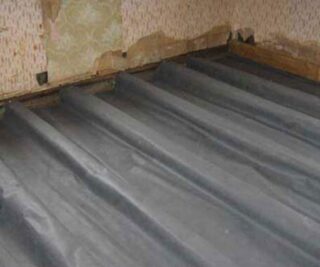Regardless of the materials chosen and the construction technologies used, the floors are the coldest part of the building. This is explained by elementary factors: contact with the ground and air circulation with different temperatures. This problem is especially acute in private houses that do not have multi-meter heated basements. The decision to insulate the floor in a wooden house is a necessity that almost all developers have to face. There are many modern and proven insulation materials.
The need for floor insulation in a wooden house

The comfort of living in a home is determined by criteria such as humidity, temperature and air exchange. The lower part of the building is the most vulnerable in terms of dampness and cold.
The need to insulate the floor in most cases is dictated by the following factors:
- Cold coming from the ground. The foundation of the building is deepened to a level of 60 cm or more. The cold is transferred to the logs, and from them to the flooring.
- Dampness. The soil is constantly moistened by underground, rain and melt water. All this in the form of vapors is transferred to the base of the building.
- Insects and rodents. A well-chosen insulation cake is able to protect the structure from the penetration of representatives of flora and fauna existing in the soil into it.
- Soundproofing. A floor without a base acts like a drum, making loud noises when walking.
It is not worth delaying with the implementation of insulation, since in its absence the destructive influence of the external environment begins immediately and acts inevitably.
Heat insulating materials
Modern technologies have contributed to the emergence of new heaters on the market. At the same time, time-tested materials are also presented in a sufficient range. The user is only required to study the features and properties of the product, and then make the best choice for himself.

The most popular types of insulation are:
- Sawdust. Natural and environmentally friendly material that can be borrowed for free at any sawmill. Possesses excellent insulating properties, does not require special skills to use. The disadvantages of sawdust are significant enough to question the advisability of their use. This is inevitable shrinkage, a tendency to rot and mold, attractiveness to rodents and insects.
- Mineral wool. In private and industrial housing, glass, slag and stone wool are used. Basalt mineral wool mats have proven themselves best. They are characterized by constant shape and size, low thermal conductivity and hygroscopicity, and resistance to mold and mildew.
- Styrofoam. It is produced in the format of plates 100x100 cm with a thickness of 20 mm or more. Differs in lightness, low thermal conductivity and an average degree of sound insulation. The sheets are inexpensive, but fragile, attract rodents, and release toxic smoke when burned.
- Expanded clay. Vulcanized clay granules have been used for a long time, are characterized by good insulating qualities and an inexpensive price. At the same time, they are hygroscopic, prone to shrinkage, and require the installation of a layer of hydro and vapor barrier.
- Ecowool. The material is cellulose fluff fibers with the addition of a binder. Applied by pressure spraying.Possesses excellent thermal insulation properties and absolute environmental safety. The downside is that cotton wool is damp and very attractive to flora and fauna.
- Penofol. Foamed polyethylene foam is a practical spacer between the subfloor and the topcoat. Provides tightness and a high level of thermal insulation.
- Polyurethane foam. Substances are used from industrial installations, and in small quantities - from cans, which are in every hardware store. Foam is an excellent thermal insulator, but it is expensive and can only be applied openly and then smoothed.
The choice of the type of insulation is determined by the floor design, the type of foundation, climatic conditions and other related factors.
Features of installation on lags

When a strip foundation is used as a base, a structure consisting of a log, rough and finish flooring is used. The floor material is selected based on the type of interior and the limit values of soil temperature in summer and winter.
In such cases, the beams are used as a frame to accommodate the thermal insulation. At the same time, special attention is paid to the processing of the lower boards, which are susceptible to dampness emanating from the ground. The best option is to cover them with waterproofing, but this is not always possible, especially when a shallow tape is made.
When the insulation is laid between the logs, polyethylene or other similar material is previously placed there. And only then the installation of insulation is carried out. Thereafter, a membrane film is applied, followed by a finishing or precoating. To ensure high-quality ventilation, grilles with a mesh are installed in the corners of the room.
The main stages of floor insulation with your own hands

It is advisable to insulate the floor in a log house even at the construction stage, when there is free access to all structures and the rooms are not crammed with furniture.
It is recommended to follow the following step-by-step instructions:
- Carrying out measurements, calculations, drawing up a layout of materials.
- Preparation of tools, equipment and equipment for the safe performance of work.
- Treatment of the lag with an antiseptic and waterproofing agents. An effective way is to impregnate wood with heated drying oil.
- Installation of the bottom waterproofing layer. It is carried out with access to the beams from below. If there is soil under the lags, the waterproofing is laid on top of the frame with filling in the corners.
- The selected insulation is applied in a manner applicable to it. Then it is compacted, leveled, and the cracks are closed.
- Covering the covering of the frame with a membrane fabric. Better to use strong, effective, durable polypropylene or more modern diffuse films.
Finally, the frame is covered with a flooring. Depending on the project, these can be finishing boards made of solid wood or WPC, plywood or chipboard panels for linoleum, tiles or laminate.
Rules for the care of the insulated wooden floor

With all its advantages, the insulated wooden floor has a number of weaknesses that negatively affect the quality of the structure and its service life. The main enemies of the system are dampness and insects. Fighting them is not difficult and does not require large investments.
The coatings must be regularly treated with antiseptics. They can be delivered to functional materials through openings in the deck or after dismantling it. It is necessary to get rid of dampness by installing ventilation grilles, up to the installation of exhaust fans. It is possible to make inconspicuous hatches through which moisture absorbers can be added to the subfloor and replaced periodically.









The film is at the bottom, and the membrane is on top - everything will rot, It must be the other way around
moisture accumulates on the film, but…. does not flow down ... the tree will rot ....
No need to fence, do as before with roofing material